Key Takeaways:
The fuel delivery app market is growing at a tremendous rate; it is expected to reach $5.84 bn in 2025 $11.93 bn by 2035.
Developing a fuel delivery app needs a user-friendly interface, real-time tracking, secure payments, and a strong marketing strategy.
Core features for a fuel delivery app must include real-time GPS tracking, secure in-app payments, a user-friendly interface, and the ability to schedule or instantly order fuel.
Developing a fuel delivery app presents logistical challenges like real-time inventory management and optimizing driver routes to ensure timely service.
The key trends in the fuel delivery app market are the integration of IoT for vehicle data, AI for demand forecasting, and a growing focus on sustainable fuel options.
The cost to develop a successful and feature-rich fuel delivery app can go from $30,000 to $150,000 or more, influenced by features like advanced tracking, payment gateway integration, and the complexity of the platform.
To take steps further in the fuel industry, take the help of a company that has experience in developing fuel delivery apps, such as JPLoft. They have outdone themselves by launching fuel apps like 2UFuel.
Are you ready to enter the fuel delivery industry? If yes, then you are on the right blog.
Let’s be honest, fuel delivery has evolved and is capturing a large market successfully. As an entrepreneur, venturing into this industry can be challenging if you don't receive tailored guidance.
As per a report, 55% of Gen Z young Americans have more delivery apps on their phones.
Thus, to achieve success in the fuel delivery industry, the only way to grasp this opportunity and take the lead is to learn and evolve.
In this guide, you will find comprehensive information covering the concept, features, statistics, reasons, benefits, business models, technology stack, and steps needed to create an on-demand fuel delivery app.
Let’s get into it:
What Is an On-Demand Fuel Delivery App?
An On-demand fuel delivery app is simply an application that helps users order fuel that is to be delivered directly to their vehicle’s location, eliminating the need for visiting a traditional gas station.
Along with this, these fuel delivery apps connect the users to the fuel vendors, who then deliver the fuel to the respective user at the specified location.
It is a convenient service that enables consumers to receive goods quickly even after placing an order.
"Fuel delivery apps are revolutionizing how we refuel - no more gas station queues, just convenience at your doorstep."
— Mobile Fuel Delivery Industry Report, 2025
Well, let’s learn more about the fuel delivery apps, their related stats, and how you can create a fuel delivery app in the section below.
Fuel Delivery App Market: Key Statistics & Trends
When you decide to step into an industry, it's important to know the stats and numbers impacting the same. Only learning about the steps to create a fuel delivery app will not work when it comes to the fuel delivery industry.
Let’s understand the key fuel delivery market statistics below.
-
The global mobile fuel delivery market is projected to grow significantly from USD 5.84 billion in 2025 to USD 11.93 billion by the year 2035.
-
Additionally, the global on-demand fuel delivery market size was USD 0.33 billion in 2024, and the market is projected to touch USD 2.37 billion by 2033, exhibiting a CAGR of 15.97% from 2025 to 2033.
-
The market size of the fuel delivery market was valued at approximately USD 5.06 billion in 2024 and is further expected to reach USD 8.75 billion by 2032, growing at a CAGR of 7.1%.
-
As per SkyQuest, the global fuel delivery system market is expected to grow from USD 2.84 billion in 2024 to USD 4.22 billion by 2032, which is growing at a CAGR of 5.1% from 2025 to 2032.
Are you ready to make a fuel delivery app? Well, if not, then the following section can be helpful.
Why Build a Fuel Delivery App?
There can be a lot more reasons to consider when it comes to “why develop an on-demand fuel delivery app?”
When you proceed to start an online fuel delivery app business, it's important that before answering “how,” you answer “why.”
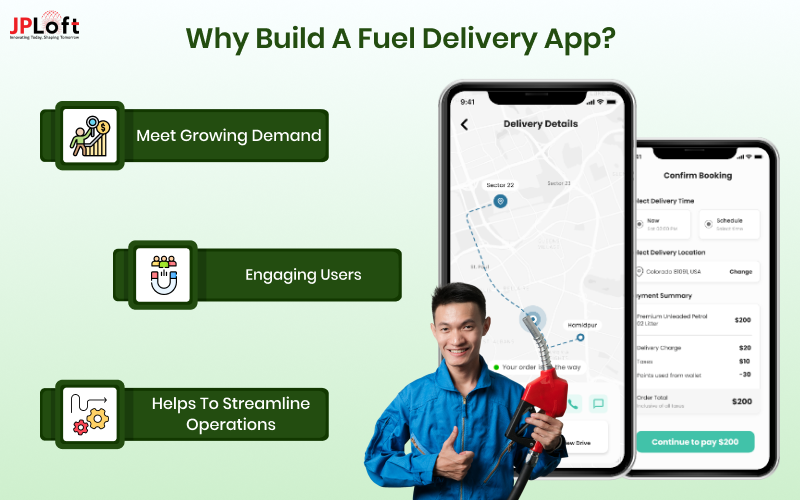
Let’s learn it all from the points mentioned below.
1. Meet Growing Demand
With the help of building a fuel delivery app, you can meet the surging demands of users in this competitive environment.
The global mobile fuel delivery system market was valued at USD 8,776.41 million in 2025, and is expected to reach USD 4,423.23 million by 2033, during the years 2025 to 2033. It represents a CAGR of 7.1% during the forecasted time.
Well, building a fuel delivery app can help you cope with these rising demands.
2. Engaging Users
A fuel delivery app can help engage users, and you can have a seamless way to order fuel from anywhere, which can eliminate the need to visit the fuel stations.
Along with this, the app will offer unparalleled convenience and time-saving solutions. It helps users to order fuel from anywhere and at any time.
These apps can help provide on-demand fuel delivery during emergencies, offering a valuable service when users require fuel urgently.
3. Helps to Streamline Operations
When you create a fuel delivery app, it can help an entrepreneur like you to streamline the operations. It will allow you to efficiently place orders, control inventory, and even drive.
With the help of the app, you can proceed with route optimization, inventory management, scheduling, and convenience, along with multiple payment options.
It helps you to reduce manual tasks and improve overall business operations. Hence, you should build a fuel delivery app.
Now, if you are thinking about the benefits, the following section can help.
Benefits of Building a Fuel Delivery App
There are various benefits of building a fuel delivery app.
In this competitive environment, it's important to stand out among competitors and build a strong brand identity to attract the target audience.
Well, before you convert the fuel delivery app startup ideas to reality, you should know the purpose. Let’s learn more about the same.
► For Users
The main target for investing in a fuel delivery app is to attract users. Here is the list of benefits you will provide after building the app.
-
Time Savings: Creating a fuel delivery app can be helpful to save time for targeted users by avoiding the time spent driving to the fuel station, refueling, and waiting in line.
-
Convenience: With the help of fuel delivery apps, users can comfortably order fuel that enhances their experience. These apps help users avoid long queues and allow them to order fuel from anywhere at any time with just a few taps on their smartphones.
-
Emergency Assistance: The fuel delivery apps provide a reliable solution to users who run out of fuel unexpectedly, especially in remote locations.
-
Saves Cost: Many fuel delivery apps assist users related to saving costs by providing them with discounted offers. Additionally, the app offers competitive pricing options with deferred payment methods.
-
Improves User Engagement: Fuel delivery apps enhance user engagement by providing a user-friendly interface, real-time tracking, and secure payment options. All these features result in enhancing the overall user experience.
► For Businesses
Here is a list of reasons to explore building a fuel delivery app.
-
Revenue Source: One of the important reasons to create a fuel delivery app is to earn revenue. You can include multiple payment options in the app, such as in-app purchases, in-app advertisements, etc.
-
Improves Brand’s Strength: When you build an app for your fuel business, it provides you with an opportunity to enhance your strength of brand through connecting with the target audiences. In the current era, the majority of people have smartphones, and building an app can help attract their attention.
-
Global Reach: Fuel delivery apps empower businesses to achieve global reach by expanding their customer base, enhancing operational efficiency, and improving service delivery capabilities.
-
Increases Efficiency: When you create a fuel delivery app, it will help you to streamline the operations by simplifying the ordering process. Additionally, fuel delivery apps assist in tracking fuel and are also beneficial for optimizing routes.
These were all the reasons to consider if you are searching for a purpose to continue building an app.
What Are the Different Types of Fuel Delivery Apps?
Learning about the business models for fuel delivery apps will help you understand the options to explore while investing.
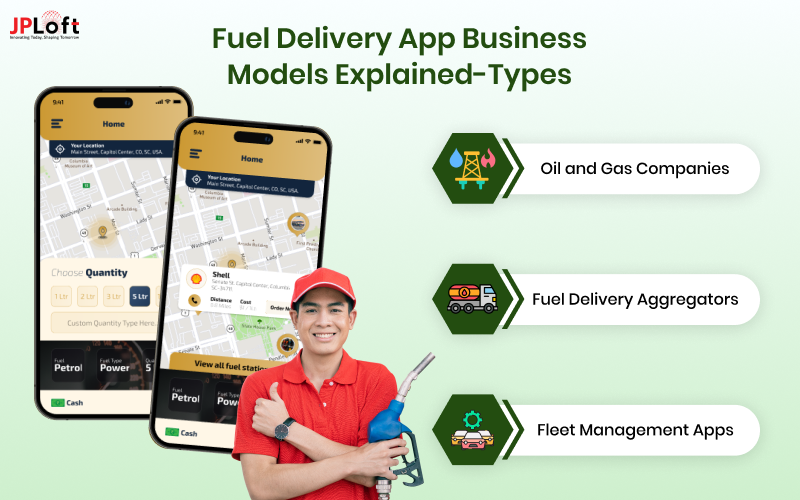
Here is the list of types of fuel delivery apps.
Type 1: Oil and Gas Companies
These are on-demand fuel delivery apps that focus on providing convenience to users by ordering fuel and getting it delivered anywhere and at any time.
The on-demand apps are focused on providing services for efficient distribution, streamlining operations, tracking deliveries in real-time, and then meeting user demands with innovative app solutions.
Type 2: Fuel Delivery Aggregators
A fuel delivery aggregator is a platform that connects customers who need fuel with multiple fuel suppliers. It is one of the platforms that connects multiple fuel suppliers with customers who seek on-demand fuel delivery.
Additionally, when you start an online fuel delivery business with this model, you provide a convenient way for diversified customers to order fuel, eliminate the need to visit gas stations, and allow users to compare prices.
Type 3: Fleet Management Apps
These apps are related to fleets, offering fuel delivery businesses to streamline operations through offering features such as real-time tracking, route optimization, and integration with fuel cards, as well as a tank monitoring system.
Here, features such as driver management, fuel card integration, and back-office system integration can be useful to businesses.
Considering all these types, you can proceed to invest in “how to build a fuel delivery app?”
Now, let’s consider the diversified features that you can include within the fuel delivery apps as per the section presented below.
Essential Features for a Fuel Delivery App
What are the top features required to develop a fuel delivery app?
For users, key features include real-time tracking, secure in-app payments, and order scheduling.
Drivers need in-app navigation and order management. The admin panel requires a central dashboard for overall control, analytics, and managing users and drivers.
Now, let's explore all these essential fuel delivery app features in a table:
|
Panel |
Feature |
Detail (Very Short Description) |
|
Admin Panel |
User Management |
Manage user accounts, roles, and permissions; view customer data. |
|
Order Management |
Oversee all orders (placed, ongoing, completed, and canceled); assign drivers. |
|
|
Driver Management |
Add/remove drivers, track performance, and manage profiles. |
|
|
Fuel Pricing |
Set and update fuel prices and delivery fees dynamically. |
|
|
Analytics |
Access reports on sales, user activity, and delivery performance. |
|
|
Notifications |
Send targeted alerts and updates to users and drivers. |
|
|
User Panel |
Fuel Ordering |
Select fuel type, quantity, and delivery location. |
|
Real-time Tracking |
Monitor the driver's location and estimated arrival time. |
|
|
Payment Options |
Securely pay via cards, digital wallets, or other methods. |
|
|
Location-based Service |
Auto-detect or manually set delivery address via GPS in fuel delivery apps. |
|
|
Order History |
View past orders, reorder quickly, and track fuel consumption. |
|
|
Notifications |
Receive updates on order status, promotions, and delivery. |
Well, after understanding these features, let’s look forward to the steps to develop a fuel delivery app in detail.
How to Create a Fuel Delivery App?
Creating a successful fuel delivery app requires a strategic approach that moves from initial planning to long-term support.
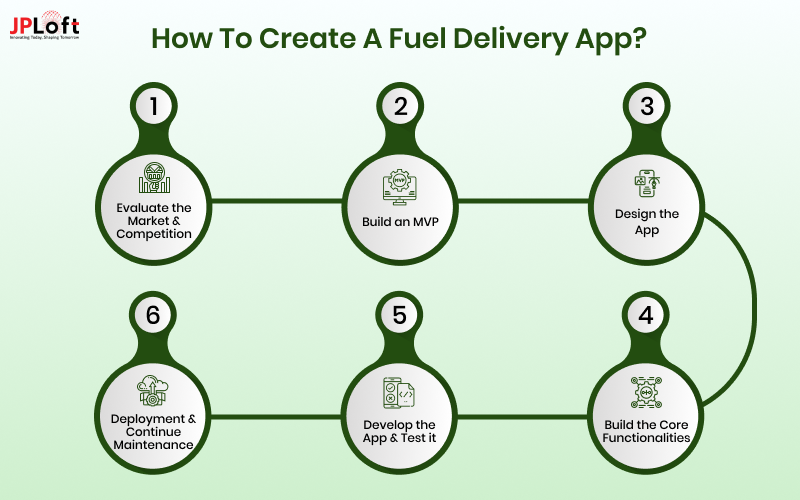
So, let’s learn how to create a fuel delivery app in this section, step by step:
Step 1: Evaluate the Market and Competition
Before a single line of code is written, a deep dive into the market is non-negotiable.
One of the first answers to how to develop a fuel delivery app lies in a thorough evaluation of the market and competition.
This phase is your foundation for a profitable business model and is essential for understanding the landscape you are entering.
It helps you pinpoint what makes your app unique and how it can successfully attract and retain users.
-
Analyze Current Trends: Stay ahead of the curve by understanding the latest trends, such as the rise of sustainable fuel options, the integration of IoT in fuel delivery apps, or drone delivery in specific regions. This strategic insight ensures your app is future-proof and aligns with evolving consumer demands.
-
Identify Competitor Strengths and Weaknesses: Study successful apps like Booster, Yoshi, or Filld. What features do they excel at? Where are their user pain points? This analysis helps you carve out your unique selling proposition (USP) and avoid common mistakes.
-
Conduct User Surveys and Interviews: Talk to your potential users directly. Understand their frustrations with traditional gas stations and what they would expect from an on-demand service. These insights are invaluable for shaping a product that truly solves a problem.
-
Assess Market Size and Growth Potential: Pinpoint which cities or regions have the highest demand for a fuel delivery service. This is your chance to identify a perfect geographical niche, ensuring a strong start for your business.
Step 2: Build an MVP (Minimum Viable Product)
Once your market research is complete, the next logical step is to build an MVP.
It ensures faster market validation and significantly reduces development costs.
It’s about creating a core product that solves a primary user problem, which you can then build upon with feedback, ensuring a user-centric and cost-effective approach.
-
Define Core Features for MVP: Focus on the essentials: user registration, a simple order placement system, real-time tracking, and a secure payment gateway. These features form the functional foundation of your app, providing immediate value to early users.
-
Prioritize Early User Needs: What's the one thing your app must do perfectly? For a fuel delivery app, it's getting fuel to the user's location reliably and efficiently. Prioritizing this core need ensures your initial offering is robust and dependable.
-
Gather Feedback from Early Adopters: Launch your MVP to a small, select group of users. Their feedback is gold, providing real-world data that tells you what works and what needs improvement before a wider, more expensive launch.
-
Improve Based on Real User Insights: Use the collected feedback to refine your app, add new features, and prepare for a wider launch. This iterative approach allows you to continuously enhance the product based on actual user behavior and preferences.
Step 3: Design the App
A solid design phase is the backbone of mobile fuel app development, ensuring both usability and engagement. A visually appealing and easy-to-navigate app is what keeps users coming back.
A thoughtful mobile app design process ensures every interaction is intuitive, making the user experience seamless and enjoyable from start to finish.
-
Create Wireframes and Blueprints: Map out the user flow and screen layouts. An effective app wireframe ensures a logical and intuitive journey for the user, from opening the app to placing a successful order, which is crucial for a smooth experience.
-
Choose Colors, Typography, and Branding: Select a color palette and font that reflect your brand identity—think of trust, reliability, and speed. These design choices create an app that is not only functional but also memorable and trustworthy.
-
The Role of UI/UX: A great UI/UX design is not just about aesthetics; it’s about making the user's life easier. For a fuel app, this means minimal taps to order and clear visibility of the delivery status, reducing frustration and enhancing satisfaction.
-
Build Interactive Prototypes and Validate Design: Create clickable mockups to test the user flow before writing any code. A well-crafted app prototype allows you to catch design flaws early and save significant time and money in the development process.
Step 4: Build the Core Functionalities
This is where the magic happens. A big part of how to develop an on-demand fuel delivery app is setting up the robust backend architecture and APIs that power the entire system.
To make this happen, you need a strong mobile app tech stack capable of handling real-time data and secure transactions.
-
Develop Backend Architecture: This is the server-side foundation that handles all app logic, including user data, order processing, and driver management. A strong backend ensures the app can handle high traffic and complex operations smoothly.
-
Set Up Databases and APIs: Secure databases are crucial for storing sensitive user information and transaction history. APIs act as the bridge between the user app, driver app, and admin panel, ensuring seamless, real-time communication between all parts of the system.
-
Security Measures: Implementing top-tier security measures, such as data encryption and secure payment gateways, is non-negotiable to protect user data. It builds user trust and ensures your platform is compliant with industry standards.
-
Decide Platforms: Will you build for iOS, Android, or go for a cross-platform solution? This decision, often made after the initial research, is based on your target audience and budget, ensuring you reach the right market effectively.
Step 5: Develop the App and Test
The development phase is where your design comes to life.
Testing is a vital step in how to create an on-demand fuel delivery app that performs seamlessly across all devices and platforms.
This phase ensures your app is bug-free, fast, and ready for public use, providing a smooth experience from day one.
-
Integrate Frontend with Backend: The frontend (what users see) is connected to the backend, allowing data to flow smoothly. This is the stage where the design and functionality are merged to create a cohesive and interactive application.
-
Conduct Functional and Usability Testing: Ensure every feature works as intended, from login to real-time tracking. Thorough mobile app testing is crucial for checking if the app is intuitive and easy to use for all users.
-
Validate Cross-Platform Performance: If your app is on both iOS and Android, rigorous testing is required to ensure a consistent experience on both platforms. This ensures your app looks and feels the same, regardless of the device.
-
Fix Bugs and Optimize Features: This is an iterative process. Bugs are addressed, and features are refined to guarantee a flawless user experience upon launch. This final polish makes your app professional and reliable.
Step 6: Deployment and Continuous Maintenance
This final step is a crucial part of any complete fuel delivery app development guide, as deployment and updates determine long-term success.
Your app is not a "one-and-done" project; it's a living product that needs ongoing care. It's also where you consider how to hire dedicated developers to manage its future.
-
Launch on App Stores: A smooth deployment on Google Play or submitting on the Apple App Store is vital. This includes preparing your app listing with compelling descriptions and screenshots that attract your target audience.
-
Provide Regular Maintenance and Updates: Post-launch, you must provide regular updates to fix bugs, add new features, and ensure compatibility with new OS versions. Fuel delivery app development maintenance is key to keeping the platform secure and relevant.
-
Monitor App Performance Metrics: Use analytics tools to track user engagement, crash rates, and other key metrics. This data will inform future updates and help you make data-driven decisions to improve your app.
-
Plan Long-Term Scalability: As your user base grows, your app's infrastructure must be able to handle increased traffic and new features without performance issues. This ensures the app can grow with your business and remain reliable.
These were some of the important processes to consider for building the fuel delivery app.
Till now, we have discussed the concept, stats, features, reasons, benefits, and the steps to make a fuel delivery app.
Now, let’s cover the details about the tech stack in the section below.
Tech Stack to Include While Building a Fuel Delivery App
What’s the right tech stack for your customized fuel delivery app?
Well, let’s explore the diversified fuel delivery app tech stack and its related details in the table given below.
|
Component Category |
Key Technologies |
Primary Purpose |
|
Frontend |
React Native, React.js, TypeScript |
User-facing mobile and web interfaces. |
|
Backend |
Node.js (Express), Python (Django/Flask) |
API services, business logic, real-time updates. |
|
Database |
PostgreSQL, Redis |
Primary data storage, caching. |
|
Cloud & DevOps |
AWS/GCP, Docker, Kubernetes, CI/CD |
Scalable infrastructure, deployment automation. |
|
Location & Mapping |
Google Maps API / Mapbox |
Geolocation, routing, real-time tracking. |
|
Payment Gateway |
Stripe / Razorpay |
Secure online payment processing. |
|
Communication |
Twilio, WebSockets |
SMS notifications, real-time chat. |
|
Monitoring & Security |
Prometheus/Grafana, OAuth/JWT |
System health, data security. |
Well, when we talk about the tech stack, we cannot avoid artificial intelligence. It is one of the essential and trendy technologies that is changing the perception of users and even businesses to enter the industry.
Whether it's fuel delivery or any other industry, you can find the exception nowhere.
Let’s cover the role of AI in detail in the section below.
How to Use AI to Build Fuel Delivery Apps?
Indeed, we cannot avoid artificial intelligence. However, we can learn to use AI for creating fuel delivery apps.
Here, let’s explore the use of AI to create fuel delivery apps in detail.
1] Collect the Data
You should evaluate the purpose of using AI, whether it's providing GPS-related services, helping the delivery person with route optimization, intelligent demand forecasting, smart pricing, etc. Clearing the goal is important to build an AI app.
2] AI Model Selection
Well, to utilize artificial intelligence, you should select the AI models on the basis of your project purpose. Here, the different AI models that can be included are route optimization models, computer vision models, natural language processing models, etc.
3] Training and Testing
Now, you should train the AI models with your specific data to validate the user performance. Along with this, you can feed the large datasets to algorithms, allowing the users to learn patterns and then provide recommendations about fuel delivery accordingly.
4] Integration
Well, you should integrate the AI tools into the fuel delivery apps. Along with this, you can implement the AI features gradually within the app structure through successful analysis of the data. Here, connecting with the leading AI app development services will help you integrate AI.
5] Monitoring
At last, you should monitor your customized fuel delivery app after AI implementation. Conduct testing and then continuously monitor the performance of the app. If you find any error, then address it effectively.
Well, you can use AI for route optimization, intelligent demand forecasting, AI-enhanced customer experience, smart pricing, fuel delivery app security and fraud detection, quality control, performance analytics, integration technologies, and inventory management.
We have already discussed the fuel delivery app development steps; now, let’s focus on the case studies in the following section.
Top Fuel Delivery Apps: Case Studies
Simply learning about the steps to make a fuel delivery app doesn’t look valid until you evaluate the competitors who are already doing well in this industry.
Hence, here is the list of the best fuel delivery apps to evaluate.
Case Study 1: CAFU
CAFU is an on-demand fuel delivery app; however, it does provide various other services to the users, such as car washes, battery and tire changes and more.
To build an app like CAFU, you need to evaluate its strategy for delivering car-related services to the users, along with its goal to help them remotely.
Case Study 2: Ezfill
Ezfill is a fuel delivery service that helps users order gas directly to their vehicle’s location using a mobile app.
When you create an app like Ezfill, the strategies that you can follow include market study, design, tech stack, testing, and maintenance. All you need to do is customize these steps as per the project's purpose.
Case Study 3: Yoshi
Yoshi is also a popular mobile app-based service that delivers propane and other car maintenance services directly to the customer’s vehicles.
If you want to evaluate “how much it costs to build an app like Yoshi, evaluate the multiple factors impacting the same, such as complexity of features, design, technology stack, etc.
Now, after evaluating these case studies, you can look for the costs and related factors in the section below.
What's the Cost to Create a Fuel Delivery App?
On average, the cost to build a fuel delivery app can vary from $30,000 to $150,000 or more, depending on the defined factors that impact it.
These factors can be the complexity of the features, design, technology stack, team of developers, security, maintenance, and many others.
Let’s learn about the mobile app development cost and its factors for fuel delivery in the brief table below.
|
Factor |
Description (Short) |
Cost Impact |
|
Complexity of Features |
Number & intricacy of app functions. |
High (More features = higher cost) |
|
Design (UI/UX) |
Quality and complexity of visual design. |
Medium to High |
|
Technology Stack |
Platform choice (iOS/Android/Web), languages, APIs. |
Medium to High |
|
Team of Developers |
Size, experience, and location of the development team. |
High (Larger/experienced teams cost more) |
|
Security & Compliance |
Measures for data protection & regulations. |
Medium |
|
Maintenance & Support |
Post-launch updates, bug fixes, and hosting. |
Ongoing (Typically 15-20% of initial cost annually) |
|
Testing & QA |
Rigor of quality assurance processes. |
Medium |
|
Marketing & Launch |
App store optimization, promotional activities. |
Variable |
Well, in the guide to build a fuel delivery app, that’s not it. When it comes to resources, time is one of the crucial aspects to consider.
Let’s learn more about the timeline in the section that follows.
How Long Does it Take to Build a Fuel Delivery App?
What’s the estimated time to create a fuel delivery app?
When it comes to building an app or a website, other than cost, time is what you need to seek and evaluate successfully. Here, the time can vary from 3 to 8 months.
Let’s figure out the timeline with steps in the table given below.
|
App Complexity Level |
Typical Timeline |
Steps Undertaken |
|
Basic (MVP) |
3-5 Months |
1. Discovery & Planning 2. UI/UX Design 3. Core Development (User, Driver, Admin) 4. Basic Integrations (Payment, Mapping) 5. Testing & Deployment |
|
Medium |
5-8 Months |
All MVP steps, plus: 1. Advanced UI/UX 2. Feature Expansion (Scheduling, Analytics, Support) 3. Improved Integrations 4. Enhanced Security 5. Rigorous Testing |
|
Advanced |
8+ Months |
All Medium steps, plus: 1. Complex Integrations (IoT, ERP/CRM) 2. AI/ML Implementation (Optimization, Pricing) 3. Scalability & Performance 4. Comprehensive Security 5. Post-Launch Support |
However, for the timeline, there are many factors impacting it, such as the complexity of the app, the skills of the developers, and the location of the developers.
Well, till now, we have discussed the app and its related scenarios. Now, let’s find out about the challenges faced while building a fuel delivery app in the section below.
Challenges in Fuel Delivery App Development
What are the key challenges for creating a fuel delivery app?
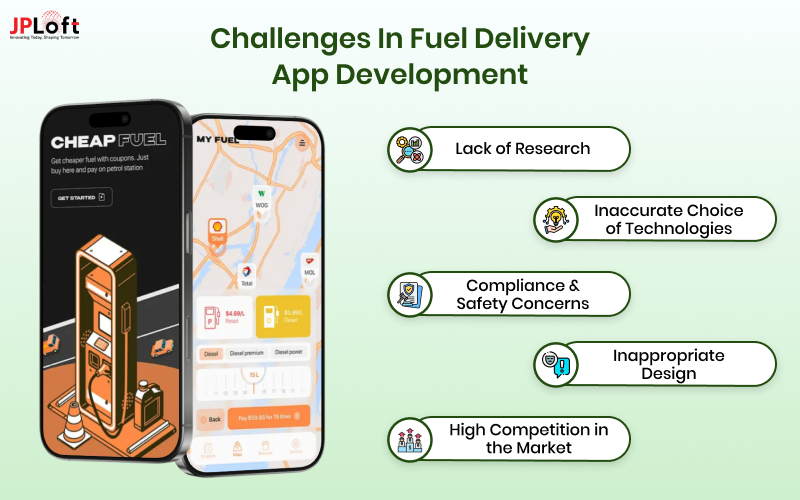
Let’s learn the challenges faced while creating a fuel delivery app, all in the list below.
Challenge 1: Lack of Research
Poor research can hinder the development of a fuel delivery app; it can even lead to poor user experience and have a large impact on the stability of your brand in this competitive environment.
Challenge 2: Inaccurate Choice of Technologies
The choice of development technologies can result in poor app performance, scalability issues, along with increased development costs.
This can impact the development of your fuel delivery app, and this can lead to significant problems, including security vulnerabilities.
Challenge 3: Compliance and Safety Concerns
While building a fuel delivery app, you can face significant compliance and safety challenges that too comprise of adhering to these strict rules and regulations for fuel transportation and dispensing.
Avoiding regulatory compliance in fuel delivery apps leads to safety errors.
Challenge 4: Inappropriate Design
Inaccurate design can result in a poor user experience, decreased user engagement, which ultimately results in failure to retain customers.
Along with this, an inappropriate design in the existing systems results in a lack of user understanding that might create confusion.
Challenge 5: High Competition in the Market
Another important factor and challenge that delivery apps can face includes high competition in the market, incentivizing innovation, which results in a better app.
However, if you ignore innovation, it can lead to a launch that is not defined.
These are some of the challenges that you should evaluate when it comes to creating a fuel delivery app.
Now, let’s proceed with the strategies that can help you earn money from a fuel delivery app in the following section.
How Fuel Delivery Apps Make Money?
Mobile app monetization strategies can be useful in identifying the effective models that can help you earn money.
.webp)
Here is the list of the top monetization models to look for:
► Delivery Fees
One of the prime sources of earning fuel is delivery charges. It is a fee for the service of bringing fuel to the particular delivery location.
This can be considered a regular income source for your fuel delivery app. However, this is a variable income that you will earn, which might change as per the user’s demand.
► In-App Purchases
You can make money by mentioning additional features in the fuel delivery apps. When it comes to in-app purchases, offering the users additional features, services, or virtual goods within the app itself.
This can be an additional source of income when it comes to fuel delivery apps. It is the extra content or subscriptions that users may buy inside the app.
► Subscription Models
Another crucial fuel delivery app monetization model that you might consider is subscription models that can provide users with unlimited or discounted deliveries for a monthly fee.
This can be a long-term and efficient subscription model where the customers pay a recurring fee for accessing your fuel delivery app.
► Partnership Model
The partnership models are important to generate revenue through expanding the reach of the brand. With the help of the partnership model, you can expand reach and order volume, which will be helpful to you in expanding your delivery network.
Along with this, the partnership model can even involve partnering with the existing fuel businesses that offer effective delivery services to the users.
Well, these are all the efficient money-making models when it comes to fuel delivery apps. Now, if you are confused about whether there is a future for fuel delivery apps, then the following section can be helpful.
Next-Generation Trends for On-Demand Fuel Delivery Apps
The on-demand fuel delivery market is rapidly evolving, with new technologies and user expectations driving the next wave of innovation.
To build a fuel delivery app that succeeds, investors and developers must focus on these emerging trends.
The future of the industry is not just about convenience; it’s about efficiency, security, and a seamless user experience, all powered by intelligent technologies.
Here’s a look at the fuel delivery app trends shaping the market:
1. AI and Machine Learning
AI in fuel delivery apps is transforming operations from top to bottom.
AI algorithms analyze historical data, real-time traffic, and weather patterns to optimize delivery routes, which significantly reduces travel time and fuel consumption for the delivery fleet.
This also allows for predictive demand forecasting, so businesses can preemptively position tankers in high-demand areas.
How investors can use this trend in their fuel delivery app:
-
Prioritize building an app that leverages AI for intelligent route optimization and demand prediction.
-
This will lead to reduced operational costs, faster delivery times, and a higher return on investment.
-
These features are essential when planning how to build a fuel delivery app that is both scalable and profitable.
2. Blockchain and Enhanced Security
Transparency and security are paramount.
Blockchain in fuel delivery apps can provide an immutable, transparent record of every transaction, from the moment fuel is loaded to when it is dispensed.
This eliminates the risk of fraud, ensures the quality and quantity of fuel, and simplifies regulatory compliance.
How investors can use this trend in their fuel delivery app:
-
By integrating blockchain, investors can enhance fuel delivery app security, positioning their app as the most trustworthy option on the market.
-
This builds customer confidence and loyalty.
-
Incorporating this technology is a key consideration when you develop a fuel delivery app for enterprise and commercial clients who require meticulous record-keeping.
3. The Rise of IoT and Advanced Tracking
While GPS tracking in fuel delivery apps is standard, the next step is integrating the Internet of Things (IoT).
IoT sensors in vehicles can monitor fuel levels in real time and automatically trigger a delivery request when the tank is low. This proactive approach ensures vehicles never run out of fuel.
How investors can use this trend in their fuel delivery app:
-
Target B2B clients and fleet managers by offering a solution that provides automated fuel management.
-
A platform that can automatically schedule and dispatch fuel deliveries for an entire fleet will be an invaluable service.
- This is a crucial feature to consider when planning how to create a fuel app for commercial use.
4. Augmented and Virtual Reality (AR/VR)
AR/VR technologies are moving beyond gaming and into practical logistics.
AR/VR in fuel delivery apps can be used for training drivers in a safe, simulated environment, preparing them for potential hazards or complex delivery situations.
AR can also be used in the driver's app to overlay navigation and safety information onto the real world, ensuring they find the precise fueling location.
How investors can use this trend in their fuel delivery app:
-
By incorporating AR/VR, investors can reduce training costs and increase driver safety.
-
This technology can be a premium feature offered to larger clients, creating a new revenue stream and demonstrating a commitment to safety and innovation.
-
It's a key differentiator during the fuel delivery app development process.
These were all the essential points to consider when it comes to evaluating the future of on-demand fuel delivery apps.
Build Your Fuel Delivery App with JPLoft!
"The way to get started is to quit talking and begin doing." - Walt Disney
JPLoft is a leading Fuel Delivery App Development Company focused on delivering projects with honesty and integrity.
We are here to help you with identifying the potential features, technologies, and other elements for achieving the purpose of your project.
We have the expertise to develop fuel apps, and as a result, we’ve completed many fuel projects. One of our standout successes is 2UFuel, which is making waves in the market.
Our team is ready to help you convert your app idea into success. We are ready to help you with conducting in-depth research when it comes to fuel delivery. With us, you can find success parameters that will help bring your ideas to life.
Conclusion
So, now you know how to build a fuel delivery app.
This journey from market analysis to seamless user experience is about much more than just tech; it’s about anticipating and satisfying the needs of a modern world on the go.
The future of fuel delivery is not just bright-it’s here. With a well-developed app, you’ll take advantage of a booming industry with unrivaled convenience and efficiency.
Your success will be based on a balance of thoughtful UI/UX, a great tech stack, and a commitment to continuous improvement.
By staying ahead of trends and prioritizing customer satisfaction, your fuel business will not only fuel vehicles but will also fuel new ideas in this industry.
FAQs
To develop a fuel delivery app, you will have to do your market research, decide on your features, plan the UI & UX, develop the app's front-end and back-end, do testing, and lastly deploy if you feel confident.
The cost to make a fuel delivery app can vary widely. A basic mobile fuel delivery app may cost anywhere from $30,000 to $60,000 for a decent product launch, while a more robust application with additional features might cost anywhere from $100,000 to greater than $150,000.
Yes, a mobile fuel delivery business can be profitable due to the convenience it offers customers, lower overhead costs compared to gas stations, and the opportunity to capitalize on a growing trend.
Mobile fuel delivery is done through a user app. A registered customer requests fuel or a scheduled delivery, and the platform dispatches a driver to the vehicle's location, where it can be fueled directly from a mobile fueling tanker truck.
Key app functions are user registration, on-demand or scheduled ordering, real-time GPS mapping, secure payment gateways, order history, and push notifications.
A Minimum Viable Product (MVP) app build will generally take 3 to 6 months, while a complex app with advanced features will take at least 9 months.






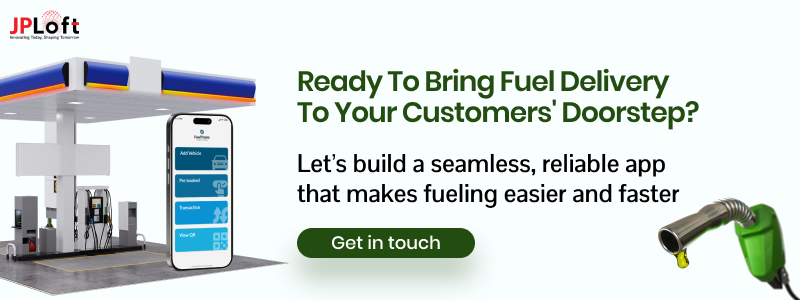

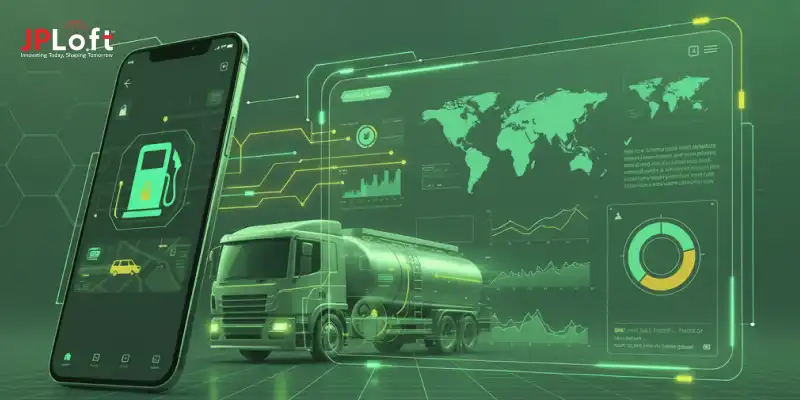
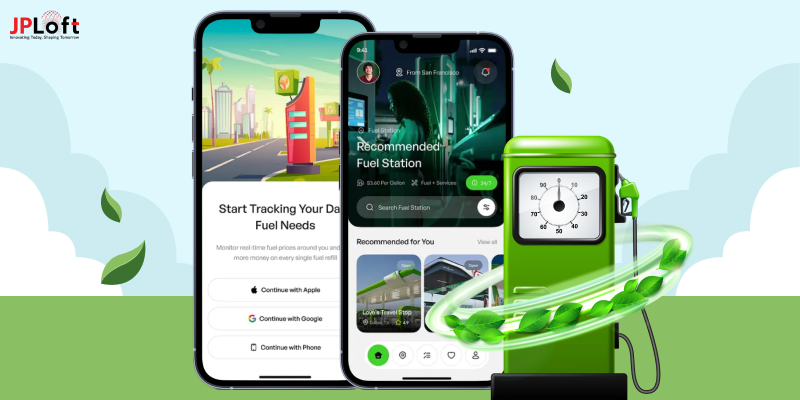
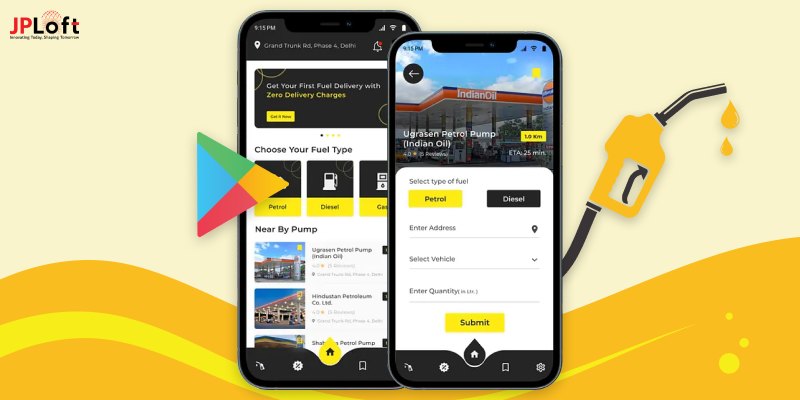


Share this blog